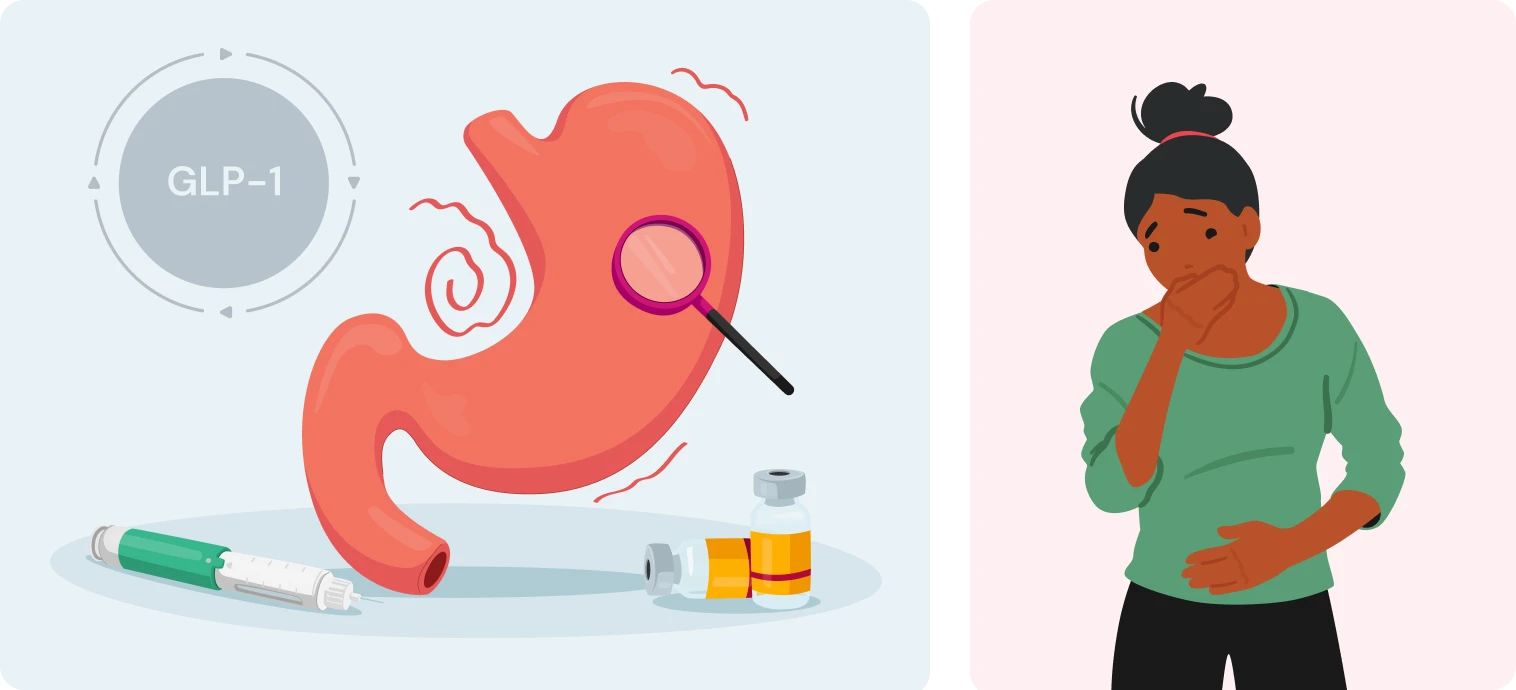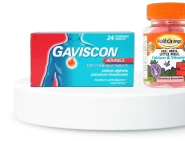Nausea and vomiting are among the most common side effects from GLP-1 injections, such as semaglutide (Wegovy) and tirzepatide (Mounjaro), for weight management or diabetes control.
Why do these GLP-1 injections often make you feel unwell? There are two main reasons. First, these medications significantly slow down how quickly your stomach empties. When food lingers longer in your stomach, that uncomfortable feeling of fullness can quickly turn into nausea.
The second reason involves your brain. These medications affect an area called the “chemoreceptor trigger zone” – essentially your body’s vomiting control centre. When this area gets activated, your body’s natural response is to feel sick or sometimes to be sick.
Together, these effects explain why so many people experience these uncomfortable symptoms when starting these treatments. Understanding this connection can help you work with your healthcare provider to manage these side effects effectively.

Key symptoms
- Persistent feeling of queasiness or the urge to vomit
- Increased salivation (watering mouth)
- Retching or dry heaving
- Actual vomiting of stomach contents
- Loss of appetite
- Potential dehydration if vomiting is severe
How common are nausea and vomiting with GLP-1 treatments?
Nausea is one of the most frequently reported side effects, affecting approximately 50% of patients taking GLP-1 medications, whilst vomiting occurs in about 15-25% of patients. These symptoms are typically most pronounced during the initial weeks of treatment, the first 24hr-48hrs after the injection and when dosages are increased. For most people, these effects tend to diminish over time as the body develops tolerance to the medication.
Managing nausea and vomiting whilst on GLP-1 treatments
Dietary adjustments
- Eat smaller, more frequent meals rather than three large ones
- Avoid very fatty, spicy, or rich foods that may aggravate symptoms
- Try bland, easily digestible foods like toast, crackers and rice when feeling queasy
- Ginger or peppermint teas may help settle the stomach
- Stay well-hydrated with small, frequent sips of cold water or electrolyte solutions
Timing strategies
- Take medication at bedtime if prescribed this way, so you might sleep through the worst symptoms
- Eat before taking your injection (if advised by your healthcare provider)
- Wait 1-2 hours after your injection before eating if taking with meals worsens symptoms
Lifestyle modifications
- Avoid lying down immediately after eating
- Practise deep breathing when waves of nausea strike
- Consider acupressure wristbands designed for motion sickness
- Maintain good ventilation in your eating environment
- Avoid strong odours that might trigger nausea
Medical approaches
- Anti-nausea medications such as cyclizine, or ondansetron may be prescribed for severe cases
- Follow the prescribed dosing schedule carefully; rapid dose increases often worsen symptoms
- Discuss with your clinician about temporarily slowing dose escalation, reducing dose or potential gap if symptoms are intolerable
When to seek medical advice
Contact your healthcare provider immediately if you experience:
- Inability to keep any fluids down for more than 24 hours
- Signs of dehydration (extreme thirst, dark urine, dizziness)
- Vomiting blood or material that resembles coffee grounds
- Severe or persistent abdominal pain
- Fever accompanying vomiting
- Symptoms that severely impact your quality of life despite management strategies
Long-term outlook
For most GLP-1 patients, nausea and vomiting are temporary side effects that become more manageable as their bodies adjust to the medication.
FAQs
Will nausea and vomiting affect my weight loss or diabetes management results?
Mild nausea and occasional vomiting may reduce your appetite in the short term, which can support weight loss goals. However, frequent or severe vomiting can interfere with proper nutrition, hydration and medication absorption. The key is to manage these symptoms effectively while continuing to benefit from your GLP-1 medication.
Should I stop taking my GLP-1 medication if I’m vomiting or feel constantly sick?
No—don’t stop your medication without medical advice. If nausea or vomiting becomes severe or persistent, speak with your healthcare provider. They may suggest adjusting the dose, slowing the titration schedule, or prescribing anti-nausea medication to help you stay on track with treatment.
Do anti-nausea medications affect how well GLP-1 medications work?
Common anti-nausea drugs generally do not interfere with the effectiveness of GLP-1 medications. However, always consult your healthcare provider before starting any new medication to ensure it’s safe and appropriate for your situation.
Is it normal for nausea and vomiting to return when my dose increases?
Yes. Many patients experience a resurgence of symptoms when stepping up to a higher dose. This is usually temporary and tends to subside as your body adjusts. It’s important to follow the prescribed titration schedule and speak to your clinician if symptoms are difficult to manage.
How can I tell if my nausea or vomiting is caused by the medication or something else?
GLP-1-related nausea and vomiting often follow a predictable pattern—typically occurring after injections, especially during dose increases and gradually improving over time. If your symptoms seem unrelated to injection timing, are worsening unexpectedly, or are accompanied by unusual symptoms (like fever or severe pain), it’s worth checking in with your healthcare provider to rule out other causes.
Related
- Bloating from GLP-1 Injections
- Common GLP-1 Weight-loss Side Effects
- Constipation from GLP-1 Injections
- Dehydration from GLP-1 Injections
- Diarrhoea from GLP-1 Injections
- Dry Mouth from GLP-1 Injections
- Injectable Weight Loss Treatments (GLP-1)
- Nausea & Vomiting from GLP-1 Injections
- Sulphur Burps from GLP-1 Injections (Mounjaro, Wegovy): How to Manage Them
- Weight Loss































